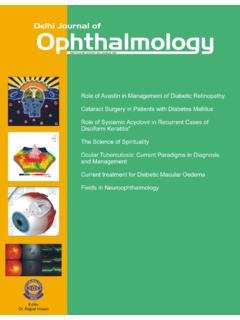Transcription of Delhi Journal of Ophthalmology - The Official Scientific ...
1 DJO 1 Vol. 21, No. 3, January-March, 2011 Delhi Journal of OphthalmologyGeneral InformationDelhi Journal of Ophthalmology (DJO), once called Visiscan, is a quarterly Journal brought out by the Delhi Ophthalmological Society. The Journal aims at providing a platform to its readers for free exchange of ideas and information in accordance with the rules laid out for such publication. The DJO aims to become an easily readable referenced Journal which will provide the specialists with up to date data and the residents with articles providing expert opinions supported with MethodologyAuthor/Authors must have made significant contribution in carrying out the work and it should be original. It should be accompanied by a letter of article can be sent by email to the Editor or a hard copy posted. Articles receive will be sent to reviewers whose comment will be emailed to the author(s) within 4-6 weeks.
2 The identity of the authors and the reviewers will not be revealed to each other by the editorial team. Detailed instructions to the contributors and for advertisement are included at the end of the ProcessThe DJO has Dr Rohit Saxena as its Editor who is assisted by a team of renowned ophthalmologists and an illustrous editorial board. The reviewers,who are leaders in their respective fields, form the back bone of the Journal by setting standards for the published Journal does not take any responsibility for the articles published in the Journal unless it is explicitly stated so. The views expressed in the articles and editorials are of the authors and do not in any way reflect the policy of the Delhi Journal of Ophthalmology . The Journal does not endorse or guarantee the quality or efficacy of any product or service mentioned or advertised in the Journal issues.
3 Advertisements carried in this Journal are expected to conform to internationally accepted medical, ethical and business OfficeDr Rohit Saxena, Room No. 479, Dr Centre for Ophthalmic Sciences, AIIMS, New Delhi -110029Ph +91-011-26593182, Email : by Dr Rohit Saxena, Editor DJO, on behalf of Delhi Ophthalmological Society, DelhiEditorial Assistant Varun KumarDelhi Journal of OphthalmologyEditor Rohit SaxenaManaging Editor Rajesh SinhaEditorial CommitteeParijat ChandraTushar AgarwalShibal BhartiyaMunish DhawanHarinder SethiRaghav GuptaAshish Kakkar Rachana MeelDigvijay SinghJitendra Chand AgarwalSwati PhuljheleReena SharmaVarun GogiaSashwat RaySaptorshi MajumdarShraddha PuranikRajvardhan AzadAtul KumarAshok K GroverMahipal S SachdevLalit VermaSharad LakhotiaP V ChaddhaDinesh TalwarK P S MalikTanuj DadaRasik B Vajpayee Rajinder Khanna Harbans LalAmit KhoslaB GhoshKirti SinghB P GulianiS P GargArun BawejaSanjay MishraTarun SharmaEditorial BoardVimla Menon Pradeep SharmaV P GuptaS.
4 BhartiAshok GargP K PandeyRamanjit SihotaDivender SoodRishi MohanNamrata SharmaVol. 21, No. 3, January-March, 2011 Delhi Journal of OphthalmologyDJO 2 ContentsEditorial 3. Where the mind is without fear Dr. Rohit SaxenaMajor Review4. Endophthalmitis Shivani Pahuja, Ritesh Narula9. The Operation Theatre : Basic Architecture Sapna, Saptorshi Majumdar, Pradeep Venkatesh15. Upshoot And Downshoot In Duane s Retraction Syndrome Suma Ganesh19. Marcus Gunn Jaw-Winking Phenomenon : A Review Dewang Angmo, Mandeep S. Bajaj, Neelam Pushker, Supriyo Ghose23. Review of doses of important drugs in Ophthalmology Yogesh Bhadange, Bhavin Shah , Brijesh Takkar, Rajesh SinhaPreferred Practice Pattern28. Systematic Approach to a Case of Disc Pallor Digvijay Singh, Rohit Saxena, Pradeep Sharma, Vimla MenonCase Reports33.
5 Bilateral Mooren s Ulcer with perforation and Iris prolapse Uday Gajiwala, Jyotsom Ganatra, Rajesh Patel, Parin Shah, Rohan Chariwala38. Acute Onset Myopia and Angle Closure Glaucoma after Topiramate Administration Nidhi Verma, Ashok KumarInstrument Scan 40. Understanding your Direct Ophthalmoscope Digvijay Singh, Rohit Saxena, Pradeep Sharma, Vimla MenonOriginal Article45. Study of Colour Blindness in Tibetan Population Navjot Kaur, Avinash Kumar, Gurinder Kaur, Jasjeet Kaur Dhillon, Manual Sutureless Small Incision Technique for Exchange of dislocated Posterior Chamber IOL Lakshminarayana Pasumala Instructions to AuthorsDJO 3 Vol. 21, No. 3, January-March, 2011 Delhi Journal of OphthalmologyWhere the mind is without fearThe relevance of Rabindranath Tagore s poem for today s the mind is without fear and the head is held high (in OPD s, rounds, OT s)Where knowledge is free (conferences, symposiums, internet)Where the world has not been broken up into fragments By narrow domestic walls (zones, institutions vs individual, govt.)
6 V/s pvt.)Where words come out from the depth of truth (in free paper sessions, articles)Where tireless striving stretches its arms towards perfection (in our work)Where the clear stream of reason has not lost its way (Duke Elder, )Into the dreary desert sand of dead habit (routine of OPD-rounds-OT)Where the mind is led forward by thee (God who gave us the opportunity to give sight)Into ever-widening thought and action (think and reach beyond routine clinical work)Into that heaven of freedom, my Father, let my country (us ophthalmologist) awake. Dear friends,The relevance of the above poem is timeless and for everyone whichever occupation we may be pursuing. It is just a reminder that we must get out of our routine and think towards becoming better and more accomplished in our work and our duty of serving the patients for which we are here.
7 Let us resolve to give our best towards the care of our The result of course is always out of our is the penultimate issue of the Delhi Journal of Ophthalmology with yours truly as the Editor and I must accept that despite the challenges of bringing out the Journal regularly with a content that is somewhat accurate, interesting and scientifically sound, my period as editor has been most enjoyable and fulfilling. Dr. Rohit Saxena The Delhi Journal of Ophthalmology is now indexed at Index Copernicus. The editorial board is involved in the task of getting the Journal indexed in other sites as well as improving the quality of articles and their presentation. This is only possible with the support of each and every DOS member. In addition to the present heads, the DJO also publishes original research including thesis work of residents.
8 We also welcome to article comments and advise on how to improve the DJO. Any DOS member who has not received the previous four issues please contact DOS Secretariat or Editor, DJO Some copies have come back due to incorrect addresses, so members are requested to please provide correct addresses and contact details to DOS 21, No. 3, January-March, 2011 Delhi Journal of OphthalmologyDJO 4 Major ReviewEndophthalmitisShivani Pahuja1, Ritesh Narula2 1 Guru Nanak Eye Centre, 2 Shroff Charity Eye is an inflammation of the internal layers of the eye resulting from intraocular colonization of infectious agents and manifesting with an exudation into vitreous cavity. Though the word endophthalmitis means any inflammation of the internal ocular spaces but in clinical practice it is usually taken to mean inflammation secondary to intraocular can be divided into two main types based on the mode of infection as: Exogenous and Endogenous (ie, metastatic).
9 Exogenous endophthalmitis results from direct inoculation as a complication of ocular surgery, foreign bodies, blunt or penetrating ocular trauma. Endogenous endophthalmitis [1] results from the hematogenous spread of organisms from a distant source of infection (eg, endocarditis).Endogenous endophthalmitis is quite rare. Various studies have reported incidence varying from 2% to 15%. In endogenous endophthalmitis, blood-borne organisms permeate the blood-ocular barrier either by direct invasion (septic emboli) or by changes in vascular endothelium caused by substrates released during infection. Destruction of intraocular tissues may be due to direct invasion by the organism and/or from inflammatory mediators of the immune response. Due to increase in the spread of AIDS, more frequent use of immunosuppressive agents, and the use of more invasive procedures, the patients at risk of endogenous endophthalmitis are increasing.
10 Most cases of exogenous endophthalmitis (49% to 76% as reported by various studies) occur after intraocular surgery. When surgery is implicated in the cause, endophthalmitis usually begins within 1 week after surgery. Post cataract endophthalmitis [2] is the most common form, with approximately of operations having this complication. This is largely due to large number of cataract surgeries being done. But the exact incidence varies in different set ups and may be very low at certain places. The overall incidence of endophthalmitis has decreased over the past several decades largely due to improved surgical technique and patient preparation. Modern estimates indicate that the incidence of infectious endophthalmitis ranges from to following penetrating keratoplasty [3] may occur early or late, the incidence of which is reported upto 2%.







